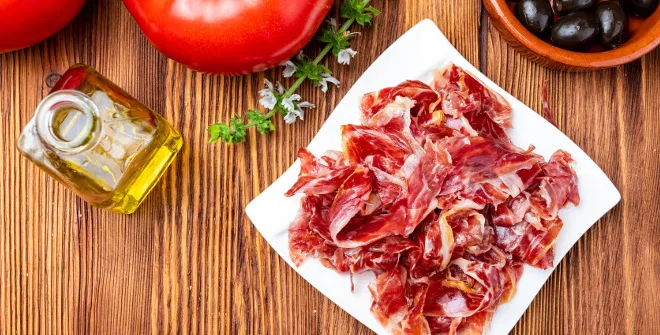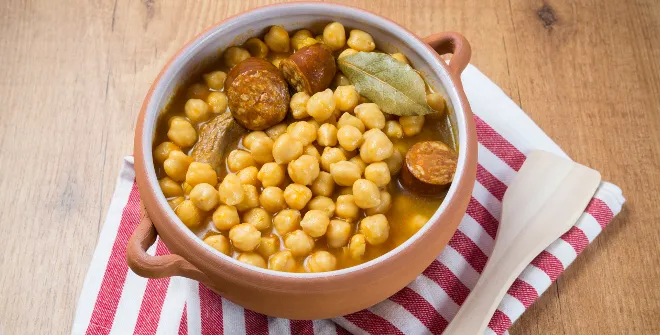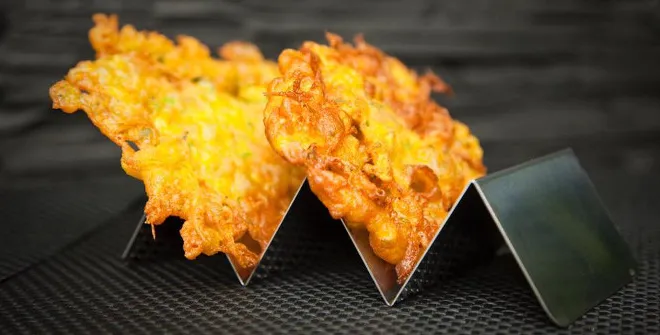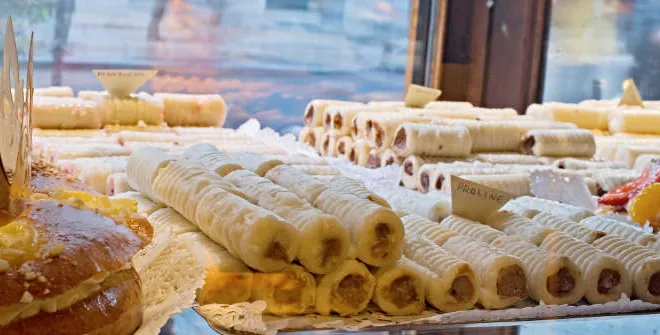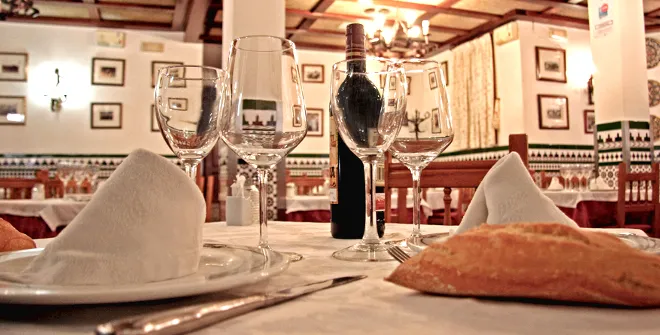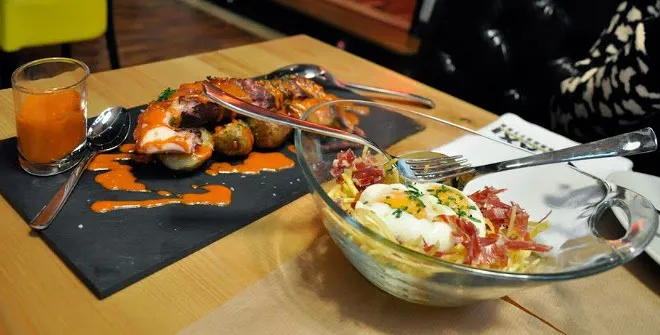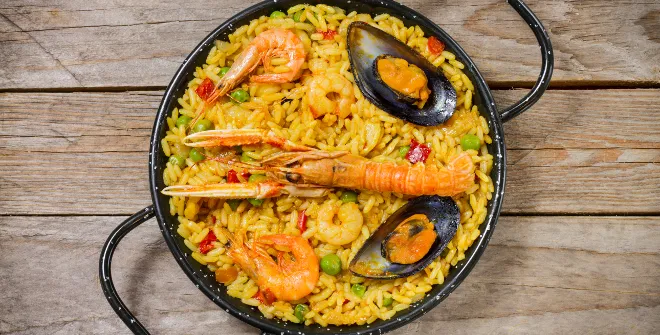Flavours from all over Spain in Madrid
Madrid has its own gastronomy with its typical recipes, of which stew in three stages, tripe, snails, squid rolls and tapas are a must. However, Madrid also allows culinary specialities from other parts of Spain to be savoured. All of the autonomous communities have “gastro” delegations in the city, so it won’t be difficult to taste the best bean stew from Asturias, the best sucking piglet from Segovia, the best calçots from Catalonia or the best Galician-style octopus, to name just a few examples. Some of the typical dishes from Spanish gastronomy are listed below so that you can also savour them on your trip to Madrid.
Paella
Typical of the Valencian Community, it is one of the icons of Spanish gastronomy. It is based on rice but has many variants: seafood paella (with fish and seafood), mixed paella (with meat and seafood) and mountain paella (with ribs, rabbit and chicken). Some renowned chefs date to experiment with more exotic ingredients, such as Rodrigo de la Calle, who has gained much success with his oyster paella. You can try this contemporary version of this unique dish at the emblematic San Miguel Market, located alongside Plaza Mayor. Do you prefer a more classic paella? Go to La Paella de la Reina, alongside the la Gran Vía or in the Peñalver Tavern. Don’t forget to have a look at our article on the leading rice restaurants in the city.
Roast Suckling Pig
Segovia and Arévalo boast the most renowned restaurants but there are also establishments in Madrid where you can try this delicious hundred year old recipe. The roast is usually cooked in an earthenware dish in a wood-fired oven and the suckling pig’s skin should be toasted and crunchy. It is said that the best roast suckling pigs in Madrid can be savoured at Coque, Botín, Casa Pedro and Los Galayos. It is worth mentioning that Castile and Leon is home to lambs and suckling pigs, one of the most typical dishes of Castilian cuisine and extremely popular in celebrations all over Spain.
Galician Octopus
In Aristotles’ classical Greece, the camouflage of the octopus was referred to. What we do not know is whether it was ever used as food. If not, a delight the people from Galicia know how to prepare like nobody else was lost. All it needs is a dash of paprika, salt and oil. In Madrid there are also many Galician restaurants where it can be savoured: La Gran Pulpería, O’Pulpo, Lúa (restaurant with one Michelin Star), Los Montes de Galicia or Villa de Foz.
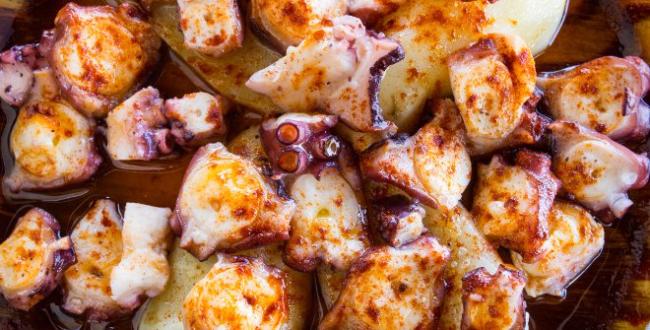
Bean Stew
This is the tastiest and most traditional dish of the rich Asturian cuisine. Prepared with fabes (white Asturian beans), spicy sausage, lard, Asturian black pudding and bacon, it is one of the typical recipes of Spanish gastronomy. It is a dish that is prepared slowly and, according to popular legend, it tastes betters a day after being cooked. In Madrid, it can be savoured at many establishments although we recommend Casa Hortensia, Asturianos, El Oso, La Hoja and the signature cuisine restaurant with its roots in Asturias, Asgaya.
Fried Fish
Typical of Andalusia, fried fish is an absolute delight as long as it is well prepared. It is usually served in a dish containing red snapper, sardines, anchovies, cuttlefish, etc. The secret lies in the product and, above all, the frying point. It is not easy, but you can try it in Madrid and you will end up licking your fingers because it is better to eat it with your fingers. Good restaurants? La Giralda, Bodega La Andaluza, Taberna del Puerto or Taberna Don Paco. At El Albero restaurant, located in Paracuellos del Jarama, they serve “Jarama” anchovies which get rid of the hiccups.
Marmitako
This is the dish par excellence of Basque cuisine. Marmitako is a hot tuna stew, accompanied by potatoes, onion, green peppers, red peppers and tomato. It is a culinary delight that is never missing on tables in the Basque Country. In spite of being a calorific stew, it is eaten more in summer because this is when long finned tuna is caught. In Madrid, you can try it in many Basque restaurants, such as Dantxari, Carlos Oyarbide, Olive Gastro, Jai Alai or Taberna Gaztelupe
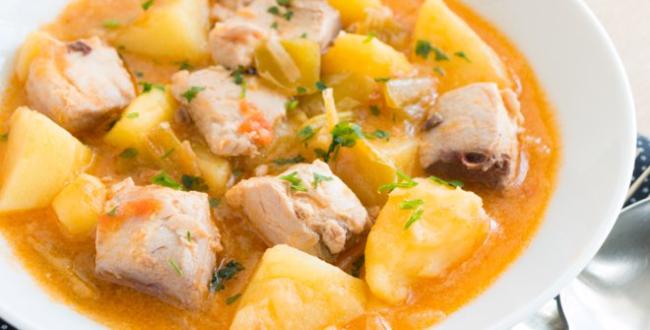
Calçots
They are a tender and bulbous variety of onion, which are commonly found in inland Catalonia. It is one of the typical dishes of Catalonian gastronomy and is eaten at the end of winter or early spring with a romesco sauce or salvitxada. They are the main feature of the calçotades, which is a festival when they served roasted on shoots. In Madrid, they can be savoured at Casa Jorge, Paradís Madrid, Can Punyetes, Candeli or La Cuina.
Oxtail
This traditional stew from Cordoba consists of an oxtail casserole which is cooked slowly in a sauce made up of onion, tomato, carrot, wine, olive oil, garlic and a few peppercorns. This recipe appears to date back to the Roman times, as there are references to it in the book, “De re coquinaria” (On the Subject of Cooking) by Apicius. The best oxtail in Madrid can be savoured at El Fogón de Trifón or at Casa Toribio. In the vicinity of the Las Ventas Monumental Bullring, you can find many restaurants specialised in this dish, such as Taberna El Burladero and Los Timbales.
Canarian Wrinkled Potatoes
It is a typical dish of the Canary Islands which is prepared with very special small potatoes, served with a sauce known as “mojo”, which can be spicy or green. If you want to try them in Madrid, go no further than Épa Bar Café, La Cecilia de Allende, Taberna Los Gallos, Picón Madrid or Gofio by Cicero Canary, which holds a Michelin Star.
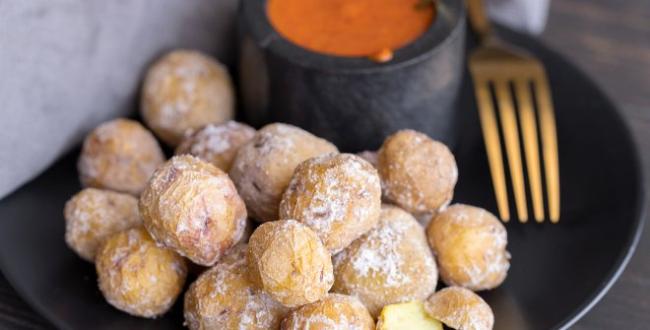
Torreznos (Pork Crackling)
Torrezno is a piece of pork rind fried or sautéed on a grill. It is an affordable delight and typically Spanish, as well as energetic. In reality, it is eaten in most of the country, normally as a tapa or aperitif, although there are variations in each region. To taste the best ones in Madrid, go to Neotaberna de Santerra, La Raquetista, Treze, Taberna Arzábal or Lakasa.
Potato Omelette
This is the national dish par excellence. It is eaten and found in all of the bars and restaurants in Spain. It is made with finely diced potatoes, oil, eggs, salt and onion, although this last ingredient has led to much debate. In Madrid, Vinos 11 Casa Dani, Hevia, Taberna Pedraza, Pez Tortilla, Las Tortillas de Gabino, José Luis or Bodega de La Ardosa. are quite rightly well known for their omelettes.
Migas (Breadcrumbs) from Extremadura and La Mancha
In different parts of Span, there are variations on this popular traditional dish. Extremadura and La Mancha stand out, where they are also called shepherd’s breadcrumbs, fried breadcrumbs or oxen breadcrumbs. According to tradition and preferences, the recipe can vary but the basic ingredients are bread, olive oil and garlic. As it is a characteristic dish of the harvest, it is often accompanied by grapes. You can try it at restaurants like La Vera, specialised in cuisine from Extremadura, Casa de Castilla La Mancha en Madrid or Hogar Extremeño de Madrid.
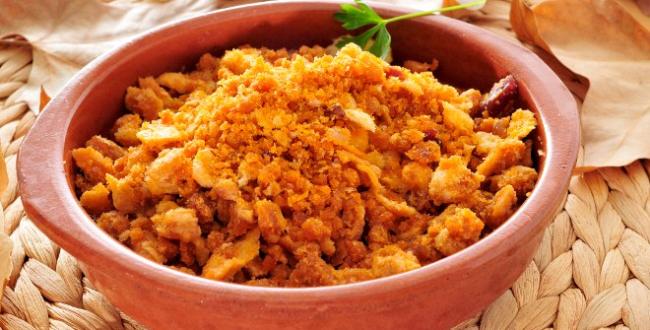
Gazpacho and Salmorejo
Two essential dishes in Spanish gastronomy which are popular in summer as they are served chilled. The difference between them is that gazpacho, often called Andalusian gazpacho, is a cold soup of vegetables seasoned with oil and vinegar whereas salmorejo is an emulsion. The former has a fine texture which enables it to be drunk from a glass or bowl, but the latter is thicker, like a cream, similar to mayonnaise. Both varieties are served at 11 Nudos Terraza Nordés whereby its salmorejo is served with diced 100% Iberian acorn-fed ham, and Lambuzo.
Iberian Ham and Cold Meats
Among the most popular food in Spanish gastronomy are cold meats, which mainly come from pigs. Popular varieties include chorizo spicy sausage, which is well cured and aired based on minced meat marinated with paprika and garlic. Black pudding, which does not contain meat and has many varieties, characterised by the use of pig’s blood, seasoned with onion, garlic and spices. Chistorra or longaniza, a typical product from Navarra prepared with freshly minced pork and fat, garlic, salt and paprika and parsley, can be eaten fried or roasted. Pork loin or cured pork loin which is eaten raw, in fine slices with a piece of bread, and pepperoni and fuet, which are both very similar to pork loin, are differentiated by their thickness, whereby fuet is the thinnest.
An emblem of Spanish gastronomy is cured ham. It can be included in the category of Serrano or Iberian ham which is prepared like bacon or boiled ham, using pork shanks. Serrano ham uses the rear legs of the pig, which are seasoned and cured in the fresh air. The front legs can be prepared in the same way, but they are called shoulders.
